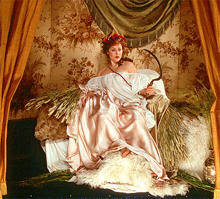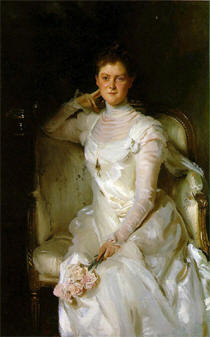 |


|
|
|
|
By John Demetry
Unlike his earlier stream-of-consciousness wonders, Distant Voices, Still Lives and The Long Day Closes--among my all-time favorite films--Davies now uses the Edith Wharton novel as a solid narrative structure. To profound effect, he applies his previous methods in unexpected manners. (He answers the fears expressed to me by America's leading neo-formalist film scholar when I asked him about Davies' thriller project that was rumored to follow the under-appreciated The Neon Bible: "I don't know what's happened to him." Whatever the subject, Davies proves he can do no wrong because he's incapable of being impersonal - or of being apolitical.) Davies' decision to adapt-to make his own--The House of Mirth is a revealing one. The story of Lily Bart is the classic stuff of women's melodramas. Her high society role of trying to ensnare a rich husband is given an arch of suspense by her increasing debts - from games of bridge and games of higher stakes. However, a love for an improper Lawrence Selden and a tendency to do the wrong thing at the right time confound her quest. These elements of her desperation also make her stick out--vulnerable to attack. She becomes society's scapegoat, which is why many critics refer to the film as "tragic." And it is tragic, but Davies understands the mechanics of tragedy as a reflection of the societal mechanisms that trap us all--in our class and in our gender roles. The post-modern imagination of Davies embroiders this archetypal form. One scene features Lily at the opera garbed in a shocking red dress-shades of Bette Davis at the ball in Jezebel and Sissy Spacek at the prom in Carrie. With this unfussy touch, Davies establishes Lily as the real spectacle. In the audience of the opera, every character projects their own anxieties onto Lily. Davies sets the movement of the images to the rhythm of the Mozart overture. Lily's fateful exit, isolated by the spotlight, meets with the applause of the audience. Like the Mozart opera whose finale is already set, so the fate of Lily is sealed. Davies' narrative fecundity provides excitement even as he distances the audience from the story. Like Bertoldt Brecht's Mother Courage, monetary transactions punctuate Lily's fall. Repeated visual motifs such as her reflection fading to black or dissolving visualize Lily's objectification.
That sets the stage for the revelatory performance given by Gillian Anderson, best known for her role on X-Files. Anderson doesn't so much become the character as tell Lily's story. That is why people are so shocked by the artificiality of her performance at the beginning. Everyone's a critic, so I've heard people in the audience dismiss these scenes as Anderson uncomfortable in the role. That's ridiculous considering the way that films are made-- there's no reason to believe that early scenes weren't shot after later scenes when, according to these people, Anderson seems more comfortable. Instead, Anderson has calibrated her performance to dramatize how she herself is responding to the character's predicaments. In true Brechtian form, this method is dramatized in the striking tableau of Lily literally transformed into a living work of art. One character's objectifying reaction: "That's the real Lily. The Lily I know." This amounts to an amazing feat that nearly everyone in the cast accomplishes as well: Eric Stoltz, Laura Linney, Dan Aykroyd, Elizabeth McGovern, and--especially powerfully--Jodhi May. The audience's emotional reactions reveal that the technique works. By humanizing the objectified, Anderson and company conquer, through Davies' unique sensibility, an intellectual conundrum: they put the blood back in Bertoldt Brecht. That last phrase is a play on Armond White's concluding line in his New York Press review of The House of Mirth, when he writes of Davies: "His final great tableau puts the blood back in John Singer Sargent." Sargent, one of two major American artistic totems resurrected by Davies' cinematics, is an appropriate subject for Davies' personal recall.
Maybe the most famous virgin in the world, the gay Davies' emotional responses to art are, in part, based on his finding solace from his loneliness--as told in The Long Day Closes. In that movie, we also saw him finding, not escape, but experience through film and music. Returning from The Long Day, another major reference point here is Orson Welles' The Magnficent Ambersons. Of course, the stories are similar, with George in the older film and Lily in the latest getting their economic comeuppance. Very likely that's why Davies chose to adapt this novel. They also share the same delicacy; the sense of dread and decay in the films' soundtracks and images, whether in the opulence of high society or in the despair of the lower-class milieu. Davies takes artworks off the walls of the museum and out of the film archives and makes them free and immediate again by pinpointing how they relate to his understanding of the world--which extends, finally, to his understanding of Lily. He connects his sense of Catholic morality, his sexuality, and his frightful childhood in poverty with Lily's gender defined role in a class-stratified society. And Davies' personal sense of history is devastating: Lily on her way to a betrayal of her ideals passes a Marxist preaching revolution to the workers. All the faux impressionistic decoration of elitist films like Howards End can't bridge this gap of time: it's already gathering dust as it projects. Davies' art follows the democratic and moral vision of the impressionists - but brings it up to post-modern date.
That moment, key to the emotional grain of the film, links with the dramatic climax. Now poor, jobless, and spiritually defeated, Lily/Anderson breaks down in front of Lawrence/Stoltz: "I have tried hard. I am a useless person, and I am on the rubbish heap. And life is difficult." The spectator cannot break free from the responsibility impressed upon by this moment. The intensity of emotion in The House of Mirth comes from Anderson and Davies' own horrified realization: "There but for the grace of art, go I." |

© 1997-2002 BEI
 Laura Linney as Bertha Dorset and Terry Kinney as George Dorset
in House of Mirth
Laura Linney as Bertha Dorset and Terry Kinney as George Dorset
in House of Mirth Gillian Anderson is Lily Bart in House of Mirth
Gillian Anderson is Lily Bart in House of Mirth The portrait of Mrs. Joshua Montgomery Sears
The portrait of Mrs. Joshua Montgomery Sears